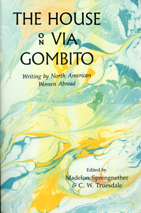Food and the countryside–two topics my Italian friends never tire of discussing. I think of their food fascination as “lingua” which means tongue as well as language, or as in the name of a nice family-run restaurant on the other side of the Arno in Florence, “Casalingua,” home tongue or home cooking. When my friend Pat Smith who’s lived in Italy since the 60s argues with me across the lunch table in refined Ferrara about how to spell and thus interpret a hometown cheese of my father’s, it’s a perfect example of this crossover from language to food. I say, “When I visited my grandfather’s hometown of Pescopagano with my father in the late 70s, his cousins explained the town cheese as “cacciacavallo,” or horse’s catch. The two round balls of cheese are covered with wax and connected by a small rope. So when horsemen went hunting, “caccia,” they threw the cheeses over the horse’s neck to have ready for lunch.”
“No, no,” Pat insists. “It’s cacio, which means cheese, or cheese carried to market on the backs of horses.”
Our mutual friend, Ruey from Vermont, also come to Italy years before married to an Italian, tries to soothe our ruffled feathers: “It’s all in how many c’s.” Now when I look up the cheese in my dizionario, I find no form of its name, but both words: caccia, to hunt, and cacio, the whole cheese. Hmmm. There in the mists of time and local dialects that cheese rises above the rims of Pescopagano mountains, two little globes connected by a rope of stars which loops into an outline of a horse.
Each town or village, paese, has its peculiarities, bred of isolation and domination by various other European powers: Spanish and French in the south; Austrian and Napoleon’s French in the north. Holding tight to home, refusing to relinguish affection to a larger nation, because for centuries after the fall of the Roman empire, there was no centralized authority, only the local priest, a distant magistrate somewhere down the mountain, and the taste of home, dialect, and food on the tongue.
Scratch an Italian and find a countryman. My father, whose trail I’m tracing to Ferrara where he studied the violin and lived on the edge of the ghetto in the mid-1920s, couldn’t have been further removed from the earth. He hated to get his hands dirty, those hands which even to the edge of his death, stroked the violin strings with talent and delight. But his speech, once he got together with his three brothers, could become quite earthy. We girls and our North Dakota Swedish and German mother disdained his silliness, his obsession with the “cesso” or toilet, and his swearing in Italian: “per de la madonna!” We, in our Protestant rigor, knew almost nothing about la madonna except at Christmas when she bore the baby Jesus and one of us might be chosen to portray her in the church pageant.
Ferrara does not have as many medallions or niches devoted to Mary such as one finds at almost every street corner in Florence. I wonder if this difference may be related to large population of Jews which before World War II lived in Ferrara. My last day there, I follow the map to the Hebrew cemetery which is just inside the city walls, and find, first, a bit of farmland inside the city. Serene, small fields are bounded by hedgerows, planted with fennel, cabbages, and herbs. A placard describes the Renaissance town planner, Rosetti’s desire to retain country life within the city, and possibly hold onto some source of nourishment in the event of siege. Huge birds I identify as some kind of woodpecker, with beige bodies and intensely blue wings, as blue as our blue jay, swoop over the fields and land, hopping like flickers. Also like flickers these birds sport a large area of white just before their tails. Later, Pat and Giangi admit they have no idea what bird I’ve seen.
Locating the Hebrew cemetery with its large metal gates and note to ring the custode, I wander for an hour in this huge, almost empty park of ginkos, oaks, and ash. Some gardeners are shoveling up the ginko seeds which are responsible for the peculiar smell which I’ve noticed even on the approach to the cemetery. I pause before graves with the names “Finzi” and “Contini,” reminiscent of the Finzi-Continis of Bassani’s novel, The Garden of the Finzi-Continis. When I checked into the very comfortable B&B, Locanda Borgonuovo, the son of the owners insisted there was no such garden. Perhaps so, but the cemetery provides a restful, enigmatic tribute to these distant people, so many killed in the Holocaust. At one edge a plain building stands with doors wide: I pause and look inside. On a black table, scarred and old, stands a menorah, or am I not remembering correctly? It seems to me some object of devotion rests there. A line of chairs faces the table, where I imagine real people as well as ghosts sometimes gather to attest to a way of life practiced for centuries and memorialized in this park.


Leave a Reply